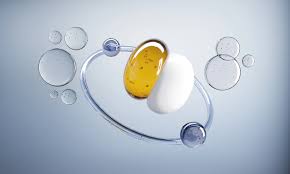
Can Hyaluronic Acid and Glycolic Acid Be Used Together?
Yes, hyaluronic acid and glycolic acid can absolutely be used together. While both are labeled as “acids,” they serve very different purposes in skincare.
Despite their names, they aren’t similar in function. In fact, they complement each other well and can even improve each other’s performance when used correctly.
Let’s explore how each of these ingredients works, the benefits of using them together, and the best ways to include them in your daily skincare routine.
What Do Hyaluronic Acid and Glycolic Acid Actually Do?
Glycolic acid is a type of alpha hydroxy acid (AHA). It is derived from sugar cane and is one of the most effective AHAs due to its small molecular size.
Its small structure allows it to penetrate deep into the skin to dissolve dead skin cells, oils, and dirt that clog pores and dull the complexion.
Using glycolic acid helps prevent common skin issues like blackheads, whiteheads, acne, and blemishes. It works by exfoliating the skin’s top layer.
On the other hand, hyaluronic acid is not an exfoliant. It’s a powerful humectant that pulls water from the environment into the skin.
This helps your skin maintain optimal moisture levels, keeping it plump, smooth, and glowing with hydration throughout the day.
Should You Use Glycolic Acid Before Hyaluronic Acid?
Yes, in most cases, it’s ideal to apply glycolic acid first. Since glycolic acid exfoliates, it clears away dead skin cells, allowing hyaluronic acid to penetrate more effectively.
Using glycolic acid first also ensures that the skin is prepped and ready to receive moisture and nutrients from follow-up products.
However, if you have very sensitive or dry skin, you might reverse the order. Apply hyaluronic acid first to hydrate and cushion the skin, then apply glycolic acid.
This alternative order helps reduce potential irritation and reinforces the skin barrier before exfoliation takes place.
In both methods, the goal is to maximize hydration and minimize the risk of dryness or redness. Always listen to your skin.
Benefits of Using Hyaluronic and Glycolic Acids Together
When combined, these two ingredients can transform your skincare routine by addressing multiple concerns at once.
Glycolic acid improves texture, unclogs pores, and fades pigmentation.
Hyaluronic acid hydrates and soothes the skin, preventing dryness.
Together, they enhance skin clarity, smoothness, and plumpness. This duo targets aging signs, dullness, dehydration, and uneven tone all at once.
Additionally, this pairing creates a well-rounded skincare foundation that prepares your skin for better absorption of other actives or moisturizers.
What Should You Avoid Mixing With Glycolic Acid?
While glycolic acid pairs well with hyaluronic acid, there are some ingredients it’s best not to mix with during the same routine.
Avoid layering it with other strong exfoliants, such as:
Lactic acid (AHA)
Salicylic acid (BHA)
Mandelic acid or other chemical peels
These combinations can lead to excessive exfoliation, weakening your skin barrier and causing irritation, redness, and dehydration.
Another common mistake is combining glycolic acid with niacinamide. Though both are excellent ingredients, their pH levels can clash.
This pH conflict may reduce their effectiveness and may trigger breakouts or allergic reactions in sensitive skin types.
Instead of layering these at the same time, you can use one in the morning and the other in the evening to avoid unwanted reactions.
Can You Use Glycolic Acid, Hyaluronic Acid, and Niacinamide Together?
Yes, it is possible to use all three — but not all at once. The key is knowing when and how to apply them for the best results.
Here’s a safe and effective routine:
Morning:
Cleanse your skin.
Apply a glycolic acid toner to exfoliate.
Follow with hyaluronic acid serum to restore hydration.
Finish with moisturizer and SPF 30 or higher.
Evening:
Cleanse your skin thoroughly.
Apply niacinamide serum to soothe, protect, and balance the skin.
Follow up with a moisturizer.
This strategy gives your skin time to process each active ingredient without becoming overloaded or irritated.
If you prefer using products that contain multiple actives, look for professionally formulated serums that include glycolic and hyaluronic acid together.
Always perform a patch test when adding new ingredients to your routine, especially when combining actives.
What Should You Apply After Using Glycolic Acid?
After applying glycolic acid, your skin is freshly exfoliated and more permeable. It’s essential to follow up with hydrating and barrier-supporting products.
The best follow-up products include:
A serum with hyaluronic acid to attract moisture
A moisturizer rich in ceramides or peptides to strengthen the skin barrier
A broad-spectrum sunscreen (SPF 30 or higher) in the morning
Skipping hydration after glycolic acid can leave your skin feeling dry, tight, and vulnerable to environmental damage.
Exfoliated skin is more sensitive to UV damage, which is why sunscreen is non-negotiable when using glycolic acid during the day.
Which Acid Is Better for Wrinkle Reduction?
Both glycolic acid and hyaluronic acid help reduce wrinkles, but they work in different ways.
Glycolic acid targets fine lines by removing the outer layer of dead skin cells, stimulating collagen production and skin renewal.
This leads to smoother skin and fewer visible wrinkles over time.
Hyaluronic acid, however, works by drawing water into the skin, plumping it up and making fine lines less noticeable instantly.
Many people mistake dehydration lines for true wrinkles, which hyaluronic acid can correct by rehydrating the skin.
So, for the best results, use both. Exfoliate with glycolic acid to renew the skin, and hydrate with hyaluronic acid to maintain firmness and bounce.
Can You Use Glycolic Acid Every Day?
Whether you can use glycolic acid daily depends on your skin type, tolerance, and the product’s concentration.
If you have oily or acne-prone skin, you might benefit from using glycolic acid daily — especially in a toner or serum form with a lower percentage.
However, those with dry or sensitive skin should limit glycolic acid use to every other day or just a few times a week.
Start slow. Introduce glycolic acid gradually, using it once or twice a week and increasing frequency as your skin builds tolerance.
High-concentration glycolic acid products (above 10%) should be used less frequently and with caution.
Always moisturize well afterward and wear sunscreen daily to protect your newly exfoliated skin from sun damage.
Final Thoughts: How to Get the Most from This Duo
Using glycolic acid and hyaluronic acid together is one of the best combinations for healthier, radiant skin.
These ingredients tackle different concerns — exfoliation and hydration — making them a powerhouse pairing.
Remember to apply glycolic acid first, then follow up with hyaluronic acid. Use sunscreen in the morning and adjust frequency based on your skin’s needs.
Avoid combining glycolic acid with other acids or niacinamide at the same time unless directed by a professional.
Introduce new ingredients slowly, patch test carefully, and be consistent with your skincare routine.
With time, this combination can improve your skin tone, texture, and hydration levels, leaving you with a smooth, glowing, and youthful complexion.


